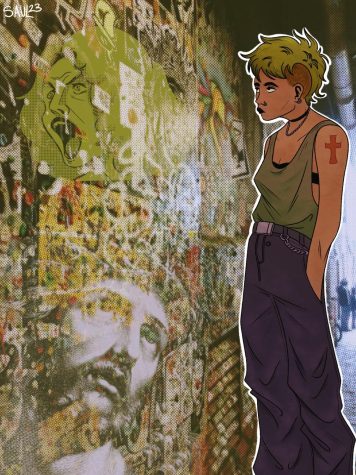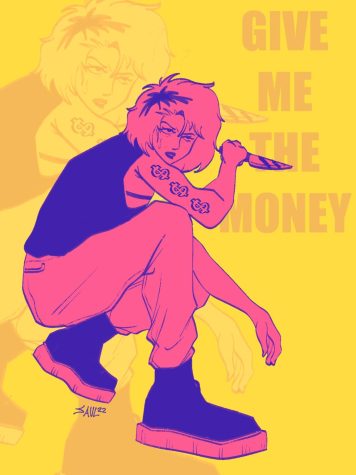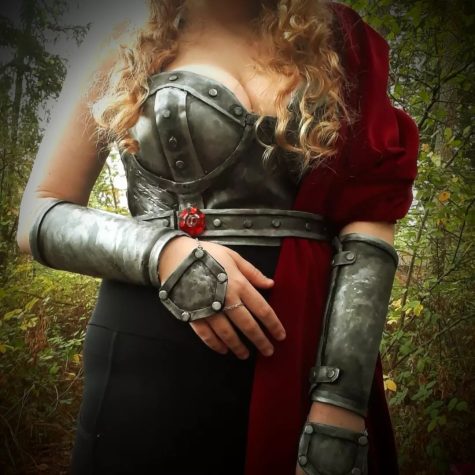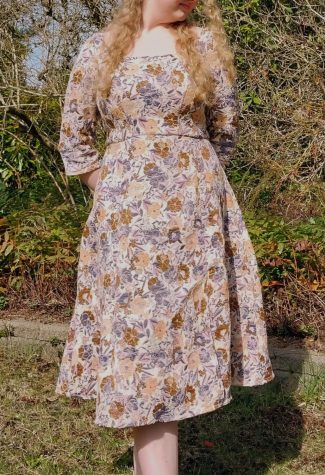Our Creativity
March 29, 2023
Welcome to The Kilt’s newest column: “Our Creativity.” Here we interview students on their wonderful various art forms. The results for this inauguration article have been awe-inspiring.
Art of any kind is a crucial part of self-expression, discovery, and creativity. Writing, sketching, painting, dancing, acting, sewing– each of these art forms is like a personalized map. Maps are a way in which we document what we know and everything we see and learn. In creating anything an artist shares their unique perspective on the world, effectively creating a map for themselves and for others.
Hazen has a thriving community of artists with more niches than can begin to be counted. Our map of the world is broad and colorful– here’s a little glimpse.
Augustus Matthews (12) practices the art of writing. Particularly, short stories. “I really like fiction, but realistic fiction that kind of dabbles into a little fantasy…without being too unbelievable. Kinda like playing with supernatural elements.” His fondness for storytelling has been present since elementary school. From a young age, he would get really into the stories he was creating. This love of storytelling has translated into a love of writing as he’s gotten older.
He is currently working on a short story which has been a work in progress for the last four years. “It’s a story of this demon reluctantly adopting a child and raising him to be the antichrist…it has taken me a while because I’m someone who can’t just sit and do something for forever. I’ll work on it for a while and then take a three-month break and go do other things.” Auggie plans to go to college to become a high school teacher. In terms of pursuing writing, “My plan is to make side money by publishing short stories, and I want this to be my first one.”
Interestingly, Auggie doesn’t like reading all that much. “In all honesty, it’s mainly because I don’t like not knowing what’s going to happen.” He adds on, “Sometimes I forget if I’m reading for fun and if I don’t like the book, I don’t have to read it. I can stop. I forget that and I feel guilty stopping books…it’s almost like I get scared that I’m gonna read the book and I’m going to get stuck reading a book I don’t like.”
For him, reading is wrapped up in a very anxious place filled with expectations whereas writing is an oasis of creative freedom. It is a common misconception that to be a writer you have to be an avid reader and enjoy reading, but you don’t. You only need a desire to be creative. Auggie adds, “If I’m in a mood to write creatively but I don’t really know what I want to write about, I put my playlist on Spotify shuffle and I create a character based off the song that plays.”
Diving into the craft Auggie explains in detail how he loves character building, “I hate when main characters are these perfect, very two dimensional [characters].” He tries to create characters who experience a depth of emotions regardless of whether they are the “hero” or the “villain.” To character build he sometimes “create[s] [the characters] in the Sims. So I can see them as a person. Or before I even start writing I have a journal where I just write down how my characters are.” It’s clear Auggie has a very thorough understanding of human interaction, “people’s emotional reactions tend to be fairly consistent like fight or flight.”
“I love the finished product. I. Love. It.” Auggie shares, when asked about his favorite part of writing is. “I love sharing it with my friends because there is nothing as rewarding as being like “hey, look what I did” and your friends being like “Oh my god, you did this? This is so good!”
For Auggie, writing has become a way of life–a pathway in which he can more deeply connect with himself. “It is a really good way to process emotions and feelings. So, like even if I’m not writing a short story, if I’ve just had a really bad day, or like I’m having complex feelings, I have a really hard time just sitting down and talking through the issue with someone…I write it all out in my notes app…because it gives me the time to work through and process what I’m trying to say…I just think writing is a really powerful way to not only express feelings towards other people but also manage your own emotions and figure out what you’re thinking.”
“It’s a risk that has no negative outcomes or impact on anyone else.”

 Saul Abolafya (12) is a digital artist and comic creator. Saul started creating comics in the third grade, “I had a buddy who really wanted two cats and she would talk about these hypothetical cats all the time so I started drawing them and making them go on little adventures and stuff. And then from there in middle school I would do a lot of sci-fi stuff and then in freshman year I continued the sci-fi thing…now I’m doing more single illustrations but I’ll start brainstorming [comics] again, it’s [still] something I enjoy.”
Saul Abolafya (12) is a digital artist and comic creator. Saul started creating comics in the third grade, “I had a buddy who really wanted two cats and she would talk about these hypothetical cats all the time so I started drawing them and making them go on little adventures and stuff. And then from there in middle school I would do a lot of sci-fi stuff and then in freshman year I continued the sci-fi thing…now I’m doing more single illustrations but I’ll start brainstorming [comics] again, it’s [still] something I enjoy.”
Saul wants to make a career out of his art. “Right now I’m thinking of storyboarding for cartoons or making small runs of comics.” He drew a lot of inspiration initially from the animated TV show “Adventure Time.” He would look up each individual storyboard artist in the credits of the show and check out their art, which is a brilliant way to expose yourself to new artists.
For inspiration, “A lot of the time…I would go on Twitter or something and I’d look at art pieces from artists I like. I like taking what they do that I like and then combining it into my own and making like a smoothie of inspiration. I really like the sketching process of brainstorming– taking all those ideas and making it my own. I also really enjoy inking. I can kind of turn my brain off, stop using critical skills, and trace which is really relaxing. I like choosing the line weights and if I want it to be angular or stuff like that. I find [that] very relaxing.” Saul is heavily influenced by artists like Jonni Phillips, Adam Muto, Victoria Vincent, Alec Robbins, Simon Handelmann, and Ann Haifisch.
To Saul, “Art is how I express things that I’m going through in life. Whether I literally draw it out or it’s more abstract and symbolic. It’s really important to me to express myself that way but it’s also just really fun and I think that’s really important too.” There is always meaning behind the work someone puts out— a statement for the world to see. Whether that be deep or emotional or just general appreciation of a subject.

 Amelia Spitzans (10) is a seamstress focusing on historical costuming with modern fantasy elements. “My favorite era [to make things for] is the 1850s…My favorite [era] to wear is the 1700s because their dresses have little peaked bodices which are so flattering and so pretty.”
Amelia Spitzans (10) is a seamstress focusing on historical costuming with modern fantasy elements. “My favorite era [to make things for] is the 1850s…My favorite [era] to wear is the 1700s because their dresses have little peaked bodices which are so flattering and so pretty.”
She hopes to make a career out of her passion and pursue costuming for movies and tv shows. Upon talking to her it is very easy to envision her accomplishing that goal. Amelia is incredibly well-versed in historical clothing and technique. “I do a lot of looking at accent garments and reading a bunch of different old pattern books that are archived. It’s actually very informative because there’s stuff that’s very beneficial to modern garments that were used historically.” She uses the knowledge she acquires to create her own pieces using “the more comfortable aspects, like cutting arm size higher on historical dresses which gives you more arm movement, but using more lining techniques from modern day…so I mix those two together to make very comfortable, very structured garments.”
A further example of her impressive understanding of the subject and practical application: “I made myself a corset that was period accurate. So it has a very high waist line and a very low bust line. But then it has cording along the hips so that it’s softer structure but then it has harder structure like the bones in the busk. So it’s a combination of a bunch of different techniques and [there’s] a lot of hand work that goes into making the silhouette of the period.”

Amelia has been sewing for about eight years but has only been making garments for about two or three. Her grandmother inspired her and taught her how to sew as well as gave her fabric to pursue the hobby. Over quarantine Amelia started to try her hand at making her own garments and hasn’t stopped since. “Most of my skirts I have made myself, I don’t like a lot of store-bought stuff. If I buy something [from the store] I will alter it…almost every single piece of clothing that I own is altered in some way.” If you see Amelia walking the Hazen hallways, chances are she’s wearing something she made herself.
She is currently working on a “1853 style ball gown that is meant for court dress. I am making it out of a vintage table cloth that my great-grandmother had…it is this really rich rose pink and I am making it into a giant hoop skirt and I’m making the hoop skirt from scratch.” She is also teaching herself how to weave lace for the aforementioned dress, “I am actually working on sourcing laces which is very difficult because there is a lot of vintage laces that are good but then modern laces don’t exactly do the same as historical ones so I’m actually learning how to weave lace.”
In creating her gowns and costumes she has acquired a ton of different skills: “foam work, so I can make armor. I can make swords…I’ve learned how to make jewelry, I’ve learned how to alter clothing, I have learned how to make garments from scratch, and I have also learned what to look for in a garment so that you know it is the most comfortable for your body.”
In terms of practicing her craft, she spends “easily three or four hours every single day on the weekdays…I will spend literally the entire day on a weekend working on a project without breaks…which ends up being 14 hours each day on the weekends.” But with that much work there is bound to be some frustration is bound to arise. To get past it, “I just keep working on it. Sometimes if I get very very frustrated I’ll take a step away from it for like a day and a half and then come back to it and see what I can work on. Oftentimes, I’ll just work through it and then take a step back and be like, ok what’s the plan from here?”
Her favorite part of her art? “I really like the end product because it is really really validating to have something that you worked so many hours on and then to be able to wear it and appreciate it.”
All these students are so incredibly talented and hopefully seeing their passion has inspired you to pursue your own unique form of expression. We at The Kilt cannot wait to bring you even more student artists.